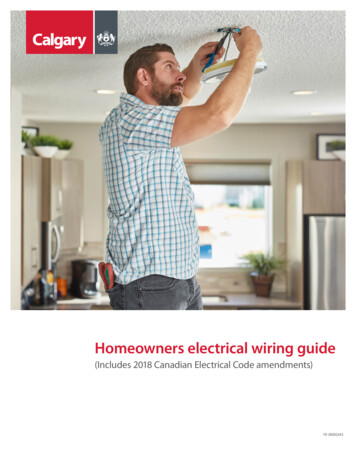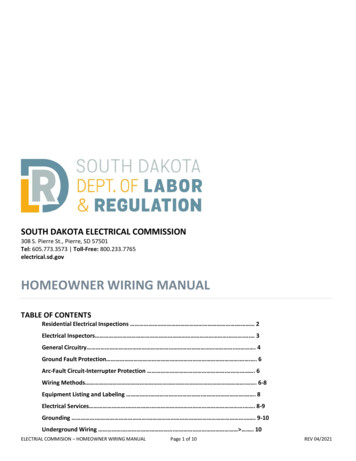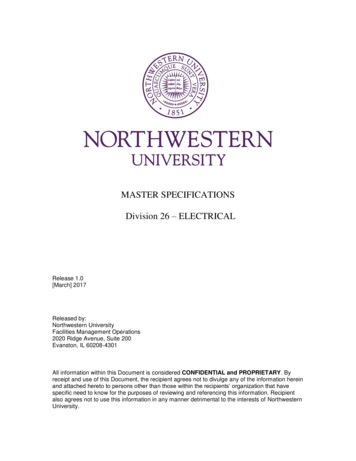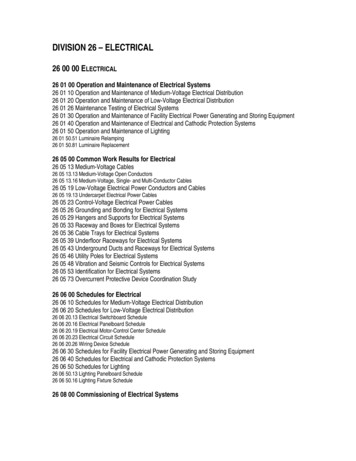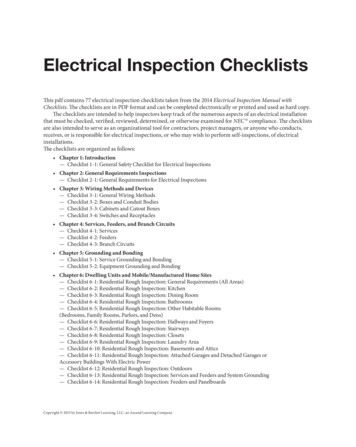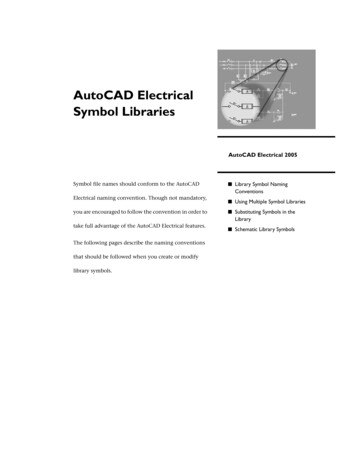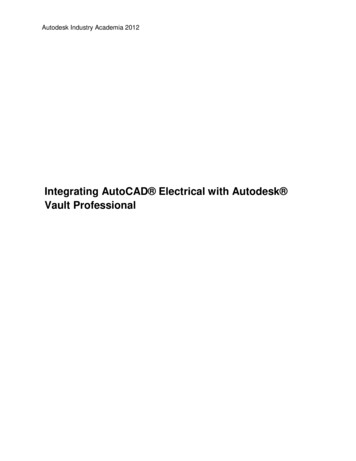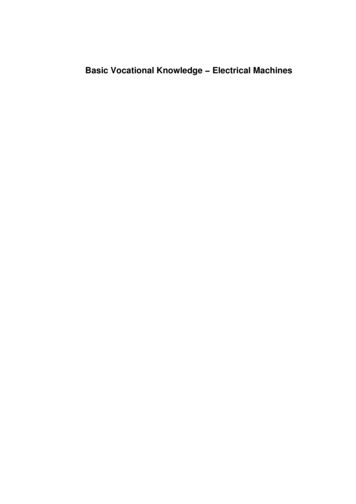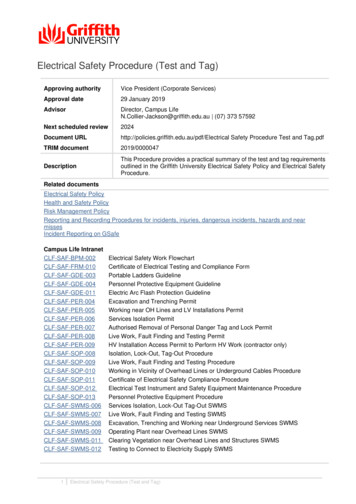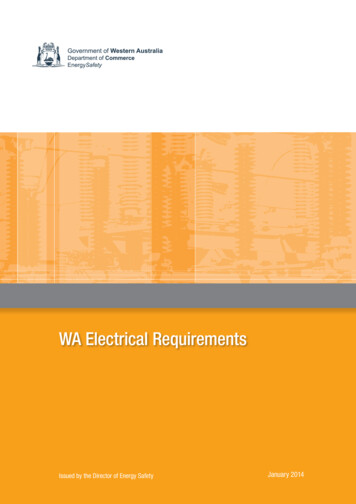
Transcription
WA Electrical RequirementsIssued by the Director of Energy SafetyJanuary 2014
PrefaceEnergy Safety Division (EnergySafety) of the Department of Commerce, following consultation with networkoperators and electrical contracting industry groups in Western Australia, issued this updated version of theWA Electrical Requirements (WAER) which applies from 1 July 2014.Electrical installation designs commenced after 1 July 2014 must comply with this January 2014 version.Designs started before 1 July 2014, and projects under construction or for which building contracts are signedat that date, may comply with the earlier July 2008 version. The application of amendments to the WAER isnot retrospective.Compliance with the WAER is mandatory under Regulation 49 of the Western Australian Electricity (Licensing)Regulations 1991. The WAER should be read with the Electricity Regulations 1947, Part VIII, and the Electricity(Licensing) Regulations 1991. Both sets of regulations take precedence.The document makes frequent references to relevant Australian Standards. As a general rule, nothing in thosestandards is replicated in the WAER. The reader needs to refer to the quoted Australian Standards.Failure to comply with a requirement may result in prosecution under the Electricity (Licensing) Regulations1991. It may also cause electricity connection delays.This latest version has been appropriately re-focussed on technical safety compliance requirements andincludes the following material changes: removal of much of the detailed information on network connection arrangements, which is nowcovered by network operators’ connection and technical requirements; and removal of matters which are now contained in other new or revised statutory instruments or technicalstandards (such as the Wiring Rules).As a consequence, the 2008 version has been significantly modified as follows: numerous changes have been made to definitions in Chapter 2; much of the content of Chapter 6 has been removed and, in particular, technical requirements forService Protection Devices have been modified; chapter 7 has been extensively modified by removal of much of the detail required in HV Submissionsbut important new provisions have been added in relation to ongoing safe operation of high voltageinstallations; the content of Chapter 8 has been deleted with the exception of matters related to Shared Bore Pumps(see new Chapter 9); and chapters 9 and 10 have been removed in entirety.Further amendments may be necessary from time to time and Industry comments will be sought on anymaterial matters prior to publication. The latest version of the WAER is available from EnergySafety’s website(http://www.energysafety.wa.gov.au).KEN BOWRONDirector of Energy SafetyFeedback on any aspect of this document is encouraged. Comments and suggestions may be forwarded,at any time, to:Director of Energy SafetyEnergySafety303 Sevenoaks Street, Cannington, Western Australia 6107fax (08 6251 1901) or email (energysafety@commerce.wa.gov.au).WA Electrical Requirements – January 2014 Edition1
Table of eral Requirements.6456723.1Supply Arrangements.63.2Earthing System.83.3On-site Power Generation.93.4Point of Supply (Underground Low Voltage).93.5Labelling. 143.6Multiple Network Points of Supply. 15LV Overhead Network.214.1Connection.214.2Service Cable Route & Point of Attachment.214.3Aerial Consumers Mains.214.4Spans and Clearances.214.5Consumer Poles.22LV Underground Network.235.1Connection.235.2Cables and Enclosures.235.3Service Connection Equipment.235.4Protection of Consumers Mains supplied from Substations.245.5Contractor Termination of Consumers Mains.24Metering and Service Equipment.256.1General.256.2Service Protection Devices.256.3Energisation.27High Voltage Installations.287.1General Requirements.287.2Design Requirements.287.3Commissioning Tests and Final Certification.29WA Electrical Requirements – January 2014 Edition
89Emergency Conditions.308.1Emergency Disconnection.308.2Repair of Damaged Installations.308.3Defective Main Switch, Service Protection Device or Boundary Fuse.308.4Consumers Mains Failure.308.5Mains Connection Box Failure.318.6Warning Notices.31Special Requirements for Installations in WA.329.1Application of Wiring Rules Part 1.329.2Consumers Mains.339.3Current-carrying Capacity of Cables in Roof Spaces.349.4Protection of Consumers Mains.349.5Protection of PV Array DC Cables.379.6Equipotential Bonding in Shower Recesses and Bathrooms.379.7Segregation of Electrical Installations.379.8Supply to Shared-use Domestic Bore Pumps.389.9Minimum Cross-sectional Area of Conductors.389.10Jointing Consumers Mains.389.11Reporting of Unsafe Electrical Installations.389.12Applicable Standards.399.13Exemptions.3910 Network Operators.4010.1Introduction.4010.2 Western Power – The Southwest Interconnected System.4010.3 Horizon Power. 4110.4 Rio Tinto Iron Ore.4210.5 BHP Billiton Limited Nickel West Leinster.4410.6 BHP Billiton Iron Ore.46Appendix 1.47Part 1 Design and Verification Certificate.47WA Electrical Requirements – January 2014 Edition3
1 IntroductionThe WAER applies to all electrical installations, whether connected to distribution networks,transmission networks or stand-alone (”off-grid”), with operating voltages up to 330kV.Nothing in this document may be used or interpreted to vary any of the requirements for a consumerinstallation specified in any of the Australian Standards prescribed in Section 9, unless:(a) details of such variation(s) are set out in this document; or(b) the relevant Standard has a specific provision for varying the prescribed requirements (for thematter in question), at the discretion of the network operator.The WAER sets out minimum requirements for all electrical installations in WA. Network operatorsmay prescribe additional or enhanced requirements as a condition of connection to their networks.4WA Electrical Requirements – January 2014 Edition
2 DefinitionsThe Act: The Electricity Act 1945;Connection requirements: The requirements of the respective network operator for connectionof an installation to its network including: technical requirements; connection arrangements; and the WADCM (applicable to Horizon Power and Western Power).Consumer: A legal entity to which electricity is supplied for the purposes of consumption.Consumer installation: An assembly of electrical wiring, components and equipment downstreamfrom the point of supply, excluding the network operator’s metering equipment, and includes all typesof assemblies, such as those in domestic residences and commercial, industrial and institutionalpremises where persons use electricity in appliances and electrical equipment.Consumer pole: A pole supplied, installed and maintained by the property owner, on the property,to provide ground clearance for the network operator’s overhead service cables (refer Figure 3.2).Consumers mains: Has the meaning given in the Wiring Rules.Contiguous: In contact with or immediately adjacent.Cyclonic area: As defined in AS/NZS 1170.2 Structural design actions Part 2: Wind actions.Director: The Director of Energy Safety, as defined in the Energy Coordination Act 1994.Distribution works: Has the meaning given in the Electricity Act 1945.Freehold title lot: (Formerly known as green title) A defined portion of land depicted on a planor diagram for which a separate Crown Grant or Certificate of Title has been or can be issued asdefined by the Planning and Development Act.High voltage: Has the meaning given in the Wiring Rules.Load: The total maximum electrical power demanded by a consumer’s installation, measured inamperes or watts. This is the maximum demand defined and calculated according to the Wiring Rules.Network operator: Has the meaning given in the Electricity Act 1945.Point of attachment: The point at which an aerial service cable is physically secured on aconsumer’s structure.Point of supply: The junction of the consumers mains with – conductors of the network operator’s distribution works (including the service cable) ortransmission works; or output terminals of electricity generation works within the premises.Professionally qualified engineer: Has the meaning given in Part 3 of the Electricity (Licensing)Regulations 1991.Property boundary: A surveyed line or border of a freehold (green), strata or purple title lot.Strata title: Lots and common property forming part of a survey strata plan under the Strata TitleAct 1985.WADCM: The Western Australian Distribution Connections Manual published by Horizon Powerand Western Power.Wiring Rules: AS/NZS 3000:2007 as published by Standards Australia.WA Electrical Requirements – January 2014 Edition5
3 General Requirements3.1Supply ArrangementsSupply arrangements for consumers shall comply with this document and other statutoryrequirements. Network operators may have additional requirements for network connection.For illustrative purposes1, typical connection arrangements for small consumers connecting to lowvoltage networks are shown in the following figures:Figure 3.1 Overhead serviceFigure 3.2 Overhead service with consumer pole1 Unless specifically defined in Section 2 of this document, terms used in these figures have the usual common meaning.6WA Electrical Requirements – January 2014 Edition
Figure 3.3 Overhead supply to consumer’s pole/main switchboardFigure 3.4 Overhead supply to rural consumer2Figure 3.5 Overhead street mains and underground consumers mains2 Underground consumer sub-mains are recommended.WA Electrical Requirements – January 2014 Edition7
Figure 3.6 Underground network and underground consumers mainsFigure 3.7 Typical underground service to multi-lot built strataIn addition, network operators should be consulted regarding their connection requirements.3.2Earthing SystemEarthing systems shall comply with the relevant technical standards, including: the Wiring Rules; AS/NZS 2067:2008 – Substations and high voltage installations exceeding 1kV a.c.; and the WA Mines Safety and Inspection Regulations 1995.The earthing system in all electrical installations shall be the Multiple Earthed Neutral (MEN) systemas defined by the Wiring Rules, unless otherwise permitted for mining operations.Further specific requirements may be found in: the network operator’s connection requirements; and Energy Networks Association EG(1) Substation Earthing Guide.8WA Electrical Requirements – January 2014 Edition
3.3On-site Power GenerationWhere sources of electricity generation are installed in a consumer’s premises, the generatorelectrical installation shall comply with relevant technical standards including: AS/NZS: 3010:2005 Electrical installations – generating sets; AS 4509.1:2009 Stand-alone power systems – safety and installation; AS 4777:2005 Grid connection of energy systems via inverters; AS/NZS 5033:2005 Installation of photo-voltaic (PV) arrays; and the Wiring Rules.Further requirements of network operators may be found in their connection requirements.In particular, where an installation has multiple alternative sources of supply (incorporating eitherautomatic and or manual switching), all associated circuits and equipment including isolatingswitches shall have signage and labelling as required by the relevant standards. Further detailedlabelling requirements are provided in section 3.5 (below).Installation or modification of on-site power generation is ‘notifiable work’ as defined in the ElectricityLicensing Regulations 1991 and, in particular, notices of work shall be submitted to the networkoperator as required by Regulations 51 and 52.3.4Point of Supply (Underground Low Voltage)3.4.1 Standard Domestic ConnectionTypical point of supply arrangements for domestic connections are illustrated in the Figures below.In particular, the following principles apply:1) A network operator’s service pillar on a lot is the point of supply for that lot and (in most cases)for the adjacent lot (see Figures 3.8(a) & (b)).2) Where a service pillar is installed on a lot, the premise on that lot must be connected to thatpillar (see Figure 3.8(b)).3) If there is no service pillar provided or intended to be provided on the lot of a standarddomestic connection then the consumer mains of the domestic connection can be connectedto a pillar on an adjacent lot provided that the pillar:– is correctly positioned as per section 5.3; and– has designated available terminals for that connection.4) A network operator’s transformer or LV kiosk located on a lot or adjacent road reserve orpublic open space is not a point of supply for a lot unless the consumers mains for the lot areconnected to it (see Figures 3.8(c) & 3.8(d)).WA Electrical Requirements – January 2014 Edition9
Figure 3.8(a) Example of points of supplyFigure 3.8(b) Example of points of supply10WA Electrical Requirements – January 2014 Edition
Figure 3.8(c) Example of points of supplyFigure 3.8(d) Example of points of supplyWA Electrical Requirements – January 2014 Edition11
Figures 3.8(e) & (f) Examples of ‘battle-axe” subdivision with and without easements3Figure 3.8(g)3 Details of how to create an easement are available from Landgate.12WA Electrical Requirements – January 2014 Edition
Figure 3.8(h)Figure 3.8(i)WA Electrical Requirements – January 2014 Edition13
Figure 3.8(j)3.4.2 Commercial ConnectionEach lot shall have its own point of supply. This shall be a service pillar, transformer or LV kiosklocated on the lot, or a transformer or LV kiosk located in the immediately adjacent road reserve orpublic open space, as determined by the network operator.3.4.3 Non-standard Connection.The network operator will determine whether the connection is to be to a service pillar, transformer,LV kiosk or other means.3.5Labelling3.5.1 GeneralLabels shall be made of material, able to withstand ultra violet radiation, extreme weather, andvandalism. They shall be indelible, durable, legible and suitably secured for the expected life of theinstallation.Technical guidance should be taken from AS 1319:1994 – Safety signs for the occupationalenvironment.Network operators should also be consulted regarding relevant details in their connectionrequirements.3.5.2 Consumers MainsThe installer shall label all underground consumers mains at the point of supply. This shall be inaddition to any Wiring Rules requirement for marking and recording of underground cable locations.Labels shall be fixed to the outer sheath of the cable in a position that is visible without unduemanipulation of the termination or the need for excavation.The minimum information on labels shall be: lot or street number (eg lot 70); unit number/alpha description (eg unit 4B); and street name.14WA Electrical Requirements – January 2014 Edition
3.5.3 SwitchboardsElectrical contractors, before requesting or carrying out energisation of an installation, shall ensurethat all switchboards are appropriately and uniquely labelled to clearly identify the board’s specificpoint of supply.3.5.4 Transformers and LV KioskThe network operator may include a label inside the transformer enclosure warning that a lot hasanother point of supply where: a network operator’s transformer or LV Kiosk is situated on a lot or immediately adjacent inthe road reserve; it is the network operator’s normal practice to connect a consumer directly to its transformeror distribution frame; and the lot is supplied by other means.Where a service pillar is located on a lot and the supply to the consumer’s installation on that lotoriginates from a transformer or kiosk, labelling within the service pillar shall identify the origin of theconsumer’s supply.3.5.5 Multiple Sources of SupplyWhere an installation includes multiple sources of supply, the electrical contractor shall placeappropriate warning labels and signage at the generation source(s), network point(s) of supply andat the main switchboard, informing operational and emergency services staff of: the existence and location of each source of supply; type(s) of supply; point(s) of isolation; and safe shutdown and isolation procedures.3.5.6 External EquipmentAny permanently installed external free standing electrical equipment that does not form part of asingle domestic installation shall be fitted with a label(s) identifying the switchboard from which itreceives supply using the unique identifier of that switchboard.Example:Supply OriginDB1Circuit R33.5.7 NotificationWhere an electrical contractor completes the termination of consumers mains, he shall provide thenetwork operator with details of the point of supply as described in section 3.5.2, and the locationof the pillar/consumers pole, location of site meters, meter numbers and installation address.3.6Multiple Network Points of Supply3.6.1 GeneralA network operator shall provide only one point of supply to an individual freehold lot, Crown landtitle or survey strata lot unless circumstances justify more than one point of supply and safetyconcerns are satisfied.The following sections apply where the network operator has approved a consumer’s application formore than one point of supply based on safety, practical and cost considerations.WA Electrical Requirements – January 2014 Edition15
3.6.2 Standard Minimum RequirementsA consumer may identify zones on a lot to which they require separate electricity supplies. In suchcases the network operator may approve more than one point of supply to the lot if, in addition toany specific conditions required by the network operator, the installation complies with the following: No low or high voltage wiring crosses zone boundaries4. Zone boundaries, wherever possible, follow easily recognisable site features such as buildings,fences or driveways and do not unnecessarily deviate from these, intermingle or crossover. An up-to-date zone diagram clearly identifying, both electrically and geographically, the extentof every zone and every zone main switchboard location, has been placed in every zone mainswitchboard and distribution board on the site. Every zone main switchboard has a unique identifier. The locations of the network operator’s points of supply and service equipment in each zoneare clearly identified on the diagram. Current copies of all zone diagrams have been provided to the network operator in anacceptable format. The labelling and signage requirements of section 3.5 and the Wiring Rules have beencomplied with, in addition to any particular identification requirements of network operators. In addition to the requirements of section 3.5, all items within 100m of the dividing zoneboundaries not part of a building (for example free standing lighting, pumps or boom gates)have been clearly labelled with the unique identifier of the zone main switchboard supplyingthem. There is a suitable location for the network operator’s service pillar(s)/equipment. A Notification under Section 70A of the Western Australian Transfer of Land Act 1893 hasbeen placed on the property title of every and each:i. freehold lotii. survey strata lotiii. built strata lotiv. Certificate of Crown land titleswarning that the property has more than one point of electrical supply. In addition a copy ofthe zone diagram and all revisions has been lodged with each Notice.3.6.3 Commercial and Industrial PremisesA network operator may provide more than one point of supply for commercial and industrialpremises where: the requirements listed in section 3.6.2 and this section 3.6.3, whichever is the more stringent,are met; each zone has a building with a minimum 4 metre-wide ground level street frontage andcontains a building with a main switchboard; a current copy of all zone diagrams has been provided to DFES and the relevant localgovernment authority in a format acceptable to them; and buildings adjacent to each other but located in separate zones have sufficient separation tobe deemed as separate buildings under the Building Code of Australia (BCA).4 Extra low voltage (ELV) wiring may cross zone boundaries provided its supply source is identified.16WA Electrical Requirements – January 2014 Edition
A separate zone may be provided for electrical equipment that is remote (electrically or geographically)from buildings or the main switchboard (such as pumps, lighting, boom-gates, communicationtowers, etc) provided: zone boundaries are a minimum of 10 metres from all associated remote equipment and thepoint of supply; and the remote equipment and associated switchboard are at least 50 metres from any buildingin an adjacent zone.Figure 3.6.3 Commercial and Industrial Premises – example of zone diagram3.6.4 Built Strata Lots – DomesticA network operator may provide more than one supply point to a group of built strata lots if therequirements listed in section 3.6.2 and the following, are met: The zones shall align with the land allocation. Each zone has a minimum 3 metre-wide ground-level street frontage and contains a buildingwith a main switchboard.3.6.5 Survey Strata Lots – DomesticFor a survey strata development zoned domestic and comprising up to three5 survey strata lots, anetwork operator may provide more than one point of supply provided the installation complies withsection 3.6.2 and the following: Each lot has a minimum 3 metre-wide ground-level street frontage and contains a buildingwith a main switchboard.5 For 4 or more lots, the network operator should be consulted.WA Electrical Requirements – January 2014 Edition17
3.6.6 Schools, Institutions and ReservesA network operator may provide more than one point of supply for schools, other institutions andreserves where: the requirements listed in section 3.6.2 and this section 3.6.6, whichever is the more stringent,are met; each zone has a minimum 4 metre-wide ground level street frontage where there is a buildingor a minimum 10 metre-wide frontage where there is no building; a current copy of all zone diagrams are provided to DFES and the relevant local governmentauthority in a format acceptable to them; and buildings adjacent to each other but located in separate zones have sufficient separation tobe deemed as such under the Building Code of Australia (BCA).A separate zone may be provided for electrical equipment that is remote (electrically or geographically)from buildings or the main switchboard (such as reserve/oval lighting, pumps or other equipment)where: zone boundaries are a minimum of 10 metres from the point of supply; and the remote equipment and associated switchboards are a minimum of 25 metres from anybuilding in an adjacent zone.Where a reserve/oval is part of the site and may be used for any sporting event, fete, fair or similargathering, requiring a temporary electricity supply, then either: a temporary supply to the lot can be provided in accordance with section 3.6.10; or a permanent switchboard may be established in a discrete zone with a separate permanentpoint of supply for provision of temporary power supplies (which shall comply in all otherrespects with section 3.6.10) to such events on the site.Figure 3.6.6 Schools, Institutions and Reserves18WA Electrical Requirements – January 2014 Edition
3.6.7 Rural and Semi-rural LotsA network operator may provide more than one point of supply if their separation is more than 200metres and the electrical wiring of each installation maintains a 50 metre separation at all times.Where these separation requirements cannot be achieved, the minimum requirements are as setout in section 3.6.2.3.6.8 Rural Subdivisions Comprising Multiple Survey Strata Lots and Common PropertyFor large rural subdivisions involving multiple survey strata lots and common property, a networkoperator may provide more than one point of supply if: the points of supply are more than 200 metres apart; all equipment downstream from the network operator’s point of supply is owned by the stratacompany; the site main switchboard(s) is established in accordance with the network operator’sconnection requirements; a site of adequate dimension is provided by the strata company/site owner for the networkoperator’s equipment; service pillars owned and installed by the strata company/site owner are readily identifiable asnot being the property of the network operator; and the network operator’s access requirements are met.3.6.9 Temporary Builder’s SuppliesThe following are the minimum requirements for provision of a temporary builder’s supply to a lotwith an existing point of supply: Temporary building supplies shall comply with the Wiring Rules. AS/NZS 3012:2010 –Ele
Wiring Rules: AS/NZS 3000:2007 as published by Standards Australia. 6 WA Electrical Requirements – January 2014 Edition 3 General Requirements 3.1 Supply Arrangements Supply arrangements for consumers shall comply with this document and other statutory requirements. Network operators

